Having some snails in the aquarium may be good for regulating the algae growth, but sometimes things get out of control, and you find yourself in the middle of a snail infestation.
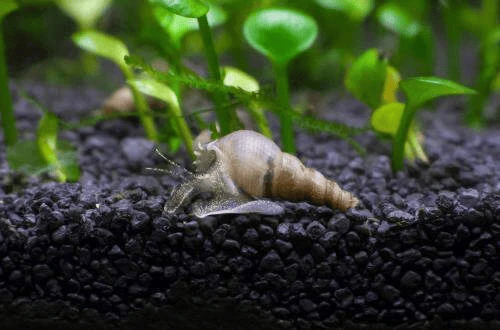
So what are the freshwater fish and invertebrates that hunt and eat aquatic snails?
There are different ways to reduce pest intruders, and one is by adding some natural predators of the snails.
In this article, I will list a few snail-eating fish and invertebrate species that will help you eradicate the ever-growing snail population in your aquarium.
What Freshwater Fish Hunt and Eat Aquarium Snails?
A predator of aquarium snails is usually a fish or an invertebrate whose diet includes protein, due to its omnivorous or carnivorous nature.
Keep in mind that these predators can be different sizes, have different temperaments, and are sometimes incompatible with other fish.
Here are some freshwater fish and inverts that will track down and eat snails in an aquarium:
1. Dwarf Botia – Ambastaia sidthimunki

By HairyCatFish
| Maximum Size: | 2.5 inches or 6.3 cm |
| Suggested Tank Size: | at least 20 gallons |
| Gets along with: | various rasbora species, Otocinclus fish, Roseline Sharks, small schooling fish that swim fast such as Zebra Danios and smaller Tetras, smaller non-aggressive Plecos such as the Rubber Lipped one |
The Dwarf Botia, more popular as Dwarf chain Loach, is one of the best small loaches that would eat snails and snail eggs in smaller fish tanks.
These fish from the Ambastaia genus do not grow bigger than 2.5 inches (around 6 cm) and are semi-aggressive in nature.
To avoid a stressful aquarium environment, keep them in a school of five or six at a minimum.
Ensure that there are enough hiding places, such as rocks, and dense plants, because those species are very active and like exploring.
Dwarf Botia fish spend lots of time not only on the bottom of the tank but in its middle part as well.
If you consider having shrimp, keep in mind that the Dwarf Chain Loach may attack them as it would the pest snails.
2. Spixi snail – Asolene spixii

By em_berk
| Maximum Size: | 1 inch (around 3 cm) |
| Suggested Tank Size: | 5 gallons and more |
| Gets along with: | all peaceful fish and shrimp, such as Cherry shrimp, Amano shrimp, Ghost shrimp. Keep Spixies away from Crayfish. |
Native to South America, the Spixi snails are members of the snail genus known as Asolene and they are rarely found at pet stores.
Easily recognizable because of their distinctive yellow colors, they are a great addition to a peaceful fish tank.
A lot of hobbyists have reported their Spixi snails to eat other larger snails, snail eggs, and baby snails.
Occasionally a Spixi would also eat other Spixi snails.
That is because they are predatory in nature.
Interestingly, these snails are Hydra eaters as well.
The Spixi snail is an underrated snail eater that I don’t see mentioned a lot.
Spixi snails can be a convenient addition to a shrimp tank that has too many pest snails. The Spixi will eat and hunt other snails, but any baby shrimp should be able to escape it.
3. Almora loach – Botia almorhae

By heydoughnuts
| Maximum Size: | 2.5 to nearly 6 inches (it really varies with this one) |
| Suggested Tank Size: | 20 to 70 gallons (20 when they’re young and small) |
| Gets along with: | Molly fish, Tetras, Angelfish, Clown loaches, Goldfish, Gourami. |
Known for its somewhat aggressive temperament, the yoyo loach is a good example of a fish that would eat all kinds of aquarium snails, including the Trumpet Snail.
The yoyo loach which belongs to the genus Botia will spend most of its time on the bottom of the fish tank, exploring it.
For this reason, you’re free to add as many easy-going species that dwell in the top and middle column of the community aquarium as you want.
The general rule here is that as long as the rest of the fish are peacefully inhabiting the middle part of the aquarium, and are as large as the yoyo loach, they are suitable to live with it.
When the Almora fish are still small, they can live in 20-gallon tanks just fine.
Once they outgrow that, however, you will need to get them a bigger tank, such as a 75-gallon one or another large fish tank with a length dimension of at least 48 inches.
The YoYo Loaches are schooling fish, so a group of minimum 5 is required for them to feel comfortable.
4. Dwarf Crayfish – Cambarellus genus
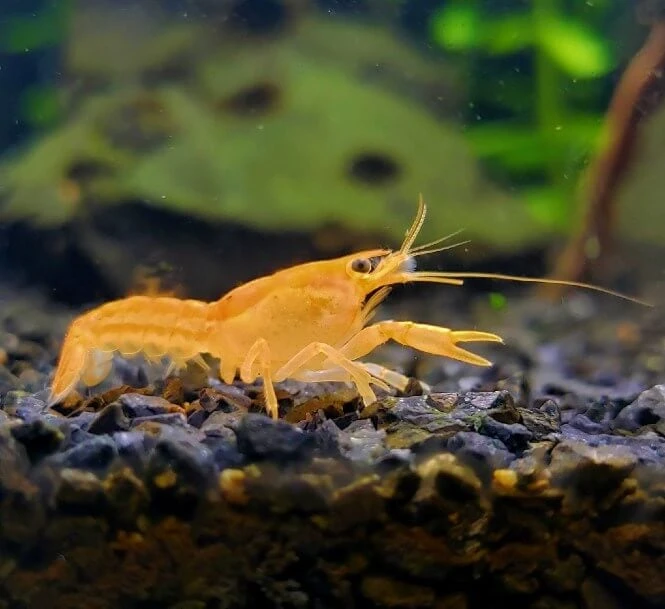
By MrMyers_
| Maximum Size: | 1 to 2 inches (around 3 to 5 cm) |
| Suggested Tank Size: | 5 gallons and more |
| Gets along with: | fast-swimming fish such as Danios, avoid other bottom dwellers as they will be harassed, tank mates big enough to eat the crayfishand and long-finned nano fish such as Guppies. |
More peaceful than the rest of the Crayfish, the Dwarf Crayfish will make a decent helper in keeping your aquarium’s snail infestation under control.
Even the pesky Malaysian Trumpet Snails will be on the Crayfish’s menu.
The small predators like this one from the Cambarellus genus of freshwater crayfish will eat all the snails they can catch.
Be careful with keeping small fish with the Dwarf Crayfish, especially the ones that rest on the bottom.
If a Dwarf Crayfish gets its tiny claws on something it will likely try to eat the victim. This includes shrimp too.
5. Paradise Fish – Macropodus opercularis

By _iammark__
| Maximum Size: | 4 inches or 10.1 cm) |
| Suggested Tank Size: | at least 20 gallons for a single Paradise Gourami |
| Gets along with: | Fish of similar size that can fined for themselves but are not overall aggressive |
The Paradise Fish is a beautifully colored species of Gourami that can snack on small snails.
If the type of snail that infests your aquarium is one of those species that remain small and do not get over an inch then a mature Paradise Fish would likely show interest in it.
A single specimen won’t completely take out a full-blown snail infestation, but it can certainly keep one under control.
Author’s note: The Paradise Fish can be feisty and aggressive towards other fish and its own kind. Coming from the Macropodus genus of labyrinth fish, they are often used for fights in China. I advise you to read up on these fish before deciding to put them in your aquarium.
Anyway, before we move on, I should also point out that other Gourami species have also been observed to snack on small snails.
However, the Paradise Gourami seems to me as one of the more efficient snail eater fish.
Also, the Paradise Gourami is a great addition to any coldwater aquarium infested with snails.
These fish thrive in cold waters.
6. Tiger botia – Chromobotia macracanthus
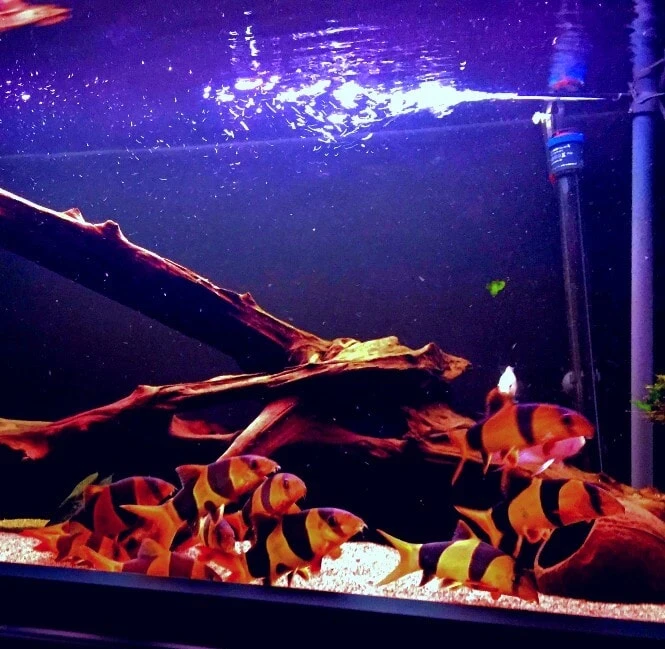
By blobb123
| Maximum Size: | 12 inches on average (30.5 cm) |
| Suggested Tank Size: | 70 gallons or larger |
| Gets along with: | Neon Tetra, Tiger Barbs, Bristlenose or Rubber Lip Pleco, rainbowfish species, Gouramis, and other tropical community fish. |
The Tiger Botia, also known as a Clown Loach, is the only member of the genus Chromobotia.
This fish is a good choice when it comes to a tropical fish that will eat pest snails in a big aquarium.
If you already own Tiger Botia, you are aware of how interesting they can be, especially when they flow carelessly around the tank and “play dead”.
Before you get them though, you need to consider a few things.
Tiger Botia loaches prefer to live in a school of at least 5 members.
Although from a certain point onward, they grow slower, they can reach between 8 and 12 inches.
Also, if your aquarium has a severe snail infestation, don’t expect these loaches to keep it entirely under control.
They like to munch on snails, but will not clean out your tank in a short time.
7. Pygmy Sunfish – Elassoma gilberti
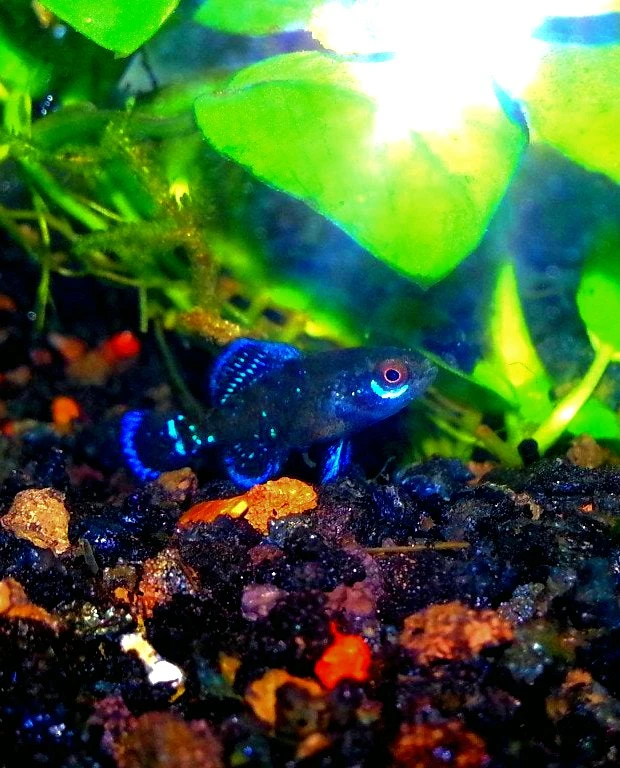
By natelanz
| Maximum Size: | 1 inch (about 2.5 cm) |
| Suggested Tank Size: | 5 gallons for a single male and 2 females or 20+ gallons for a group of 6 fish |
| Gets along with: | Heterandria formosa, Scarlet Badis, Dwarf Gourami fish, other small and calm fish species. |
The Pygmy Sunfish is a native North American nano fish.
Coming from the Elassoma genus, the adorable Pygmy Sunfish is also liked for its adaptiveness to small aquaria.
It’s almost impossible to find it in local pet shops, but some online freshwater fish stores will likely have it.
Otherwise, you can check for local vendors trading such native species, or you can rely on your skills and catch one yourself.
If you live in Texas, Florida, Indiana, or even Alabama, you might try your luck, as these are some of the natural habitats of Pygmy Sunfish.
Before that, of course, check the local law and whether the species is banned to keep.
Anyway, these beautiful fish will get along with other calm species and will bring a pinch of colorfulness to your aquarium.
The Pygmy Sunfish is one of the smallest nano fish that would eat and hunt smaller snails and their babies.
It is not a good idea to rely on Pygmy Sunfish to eat the Malaysian trumpet snails, as this type of snail has a shell that’s too hard for the fish to overcome.
8. Polka Dot Loach – Botia kubotai
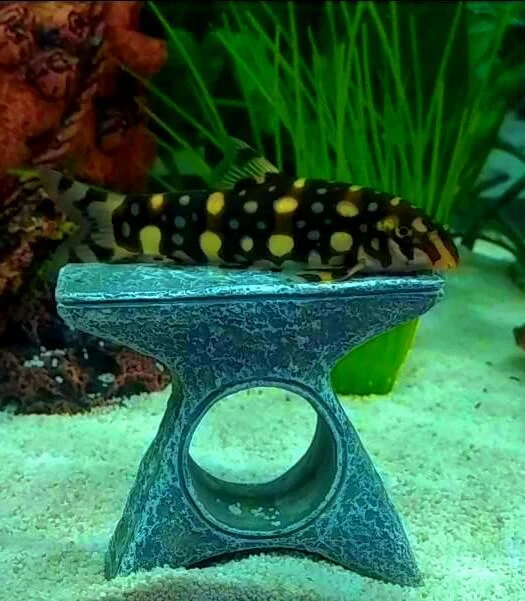
By Hideiko
| Maximum Size: | 4 to 6 inches (10 to 15 cm) |
| Suggested Tank Size: | 30 gallons but preferably larger |
| Gets along with: | most schooling Tetras and other fish with similar size and behavior, Kuhli loaches, most Plecos, catfish, other loaches. |
The Botia kubotai, also known as a Polka Dot Loach, is an excellent snail eater fish to add to a big community fish tank that has lots of live plants.
Like most of the Loaches from the genus Botia, they will spend their time around the bottom and will not cause any problems for the middle or top dwellers.
They get along with other Angelicus Loaches (another name for the Botia Kubotai), so keeping them in a group of 3 to 5 is a good idea.
Considering their semi-aggressive nature, these loaches should not be kept with really small fish unless the Polka Dots are in a sizable school of their own, keeping them busy.
The Polka dot Loaches are also suitable companions for other species, hanging out on the bottom, such as Corydoras and other Catfish.
If your fish tank is infested with unwanted aquatic snails, the Botia Kubotai loaches will not hesitate to clean it without any complaints.
9. Pumpkinseed Sunfish – Lepomis gibbosus
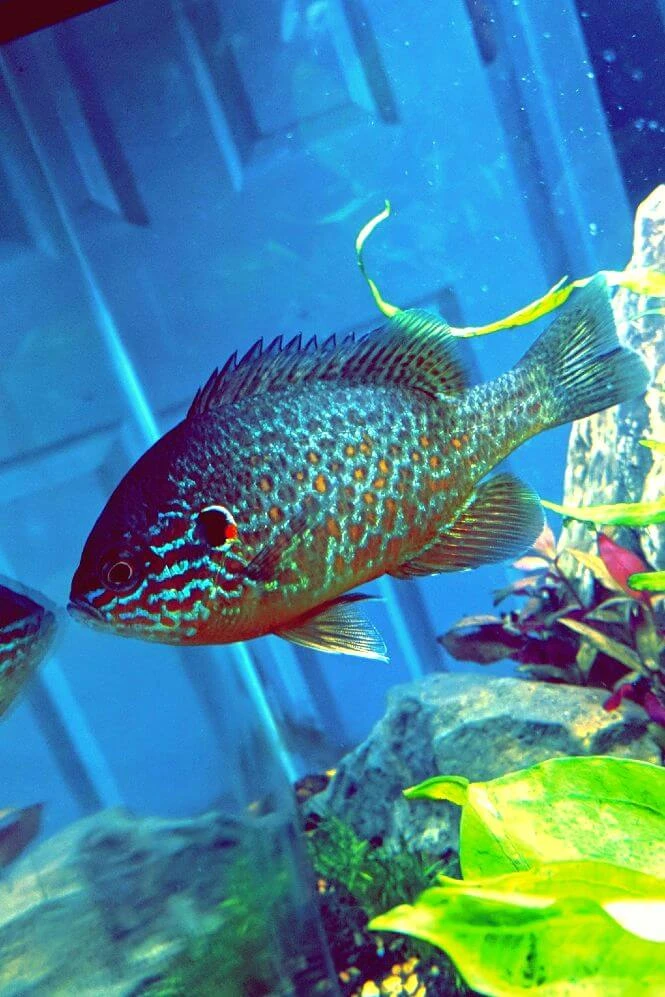
By jd_246
| Maximum Size: | about 4 inches (with some reported cases of 10 inches) (10 centimeters on average) |
| Suggested Tank Size: | 55 gallons or more |
| Gets along with: | considering their aggressive temperament and territorial behavior, it is likely best to keep these fish in a group of their own, without any other species. Some native fish from their biotope are acceptable as tank mates. |
A bright addition to a large fish tank, the Pumpkinseed Sunfish will be a suitable helper in significantly reducing the snail population in your aquarium.
The Pumpkinseed Sunfish feed on worms, snails, and even small fish.
They are an aggressive species, a typical behavior for the specimens of the Lepomis genus, so don’t mix them with other aggressive or tiny fish.
Check your local regulations if you consider keeping Pumpkinseed Sunfish, as you may need to catch them yourself and that’s not always allowed, depending on the state you live in.
These fish are also hard to find in a local pet store but there are some online vendors who sell them.
10. Assassin snail – Clea Helena
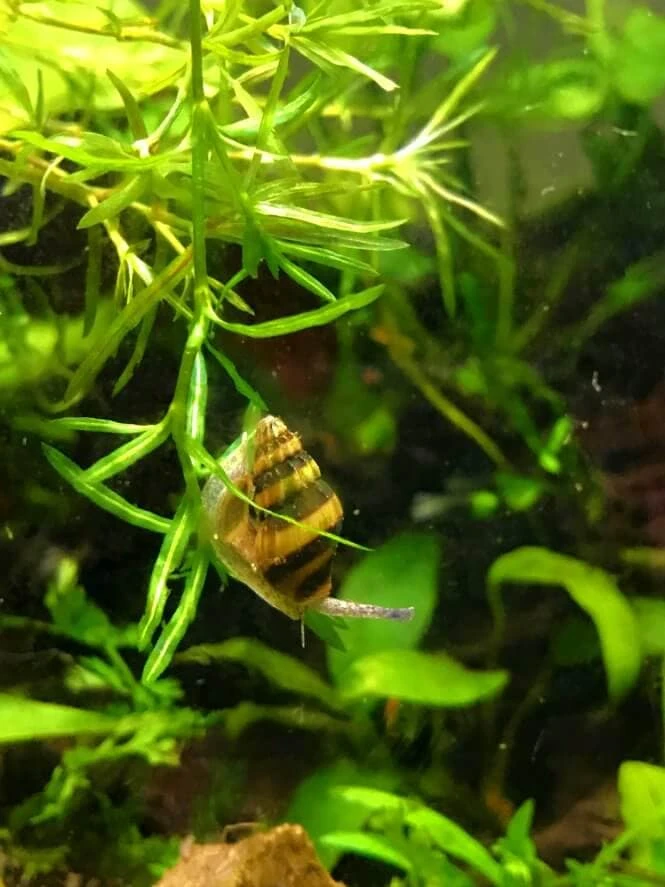
By kittenpartypdx
| Maximum Size: | 3 inches or 7.5 cm |
| Suggested Tank Size: | 10 gallons or larger |
| Gets along with: | any peaceful community fish, but do avoid any other fish listed in this article. |
The Assassin snail is, perhaps, one of the best additions to a non-aggressive fish tank community.
It is also a suitable choice for beginner aquarists.
While those critters are snails, they are different types of snails.
Members of a genus named Clea, these species are known as “assassin snails” for their habit of eating other snails.
Assassin Snails pay little to no attention to all aquarium inhabitants and focus on their main goal – hunting other snails down.
They will hide and wait for the right moment to attack all other snails in the fish tank. The menu of an Assassin Snail includes Pond snails, Trumpet, and Ramshorn snails among others.
However, keep in mind that Assassin Snails do not consume their own eggs or the eggs of the other Assassin Snails in the tank.
Luckily, they do not breed at the insane rate other aquarium snails do.
Assassin snails are a good snail-eating critter for shrimp tanks infested with smaller pest snails. If you have any dwarf shrimp or baby shrimp, be aware that some of them, such as the Cherry shrimp, may also become prey to these hitman snails.
However, most of the victims will be other pest snails.
An assassin snail can’t really make a dent in a shrimp population.
11. Longear Sunfish – Lepomis megalotis
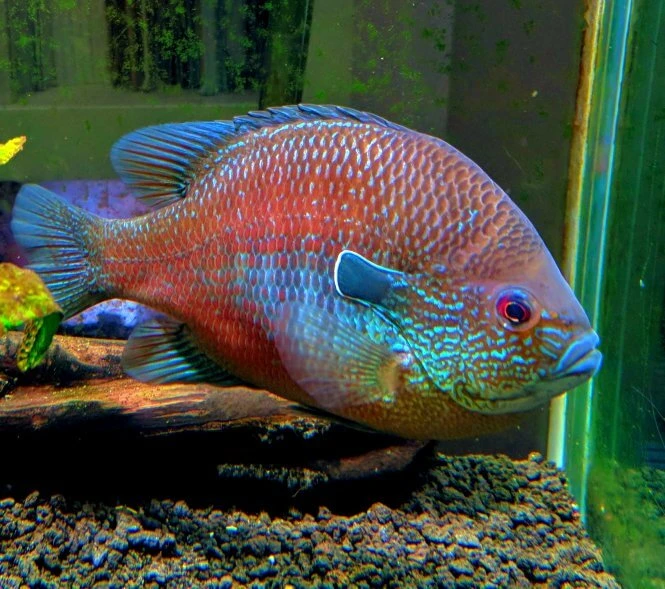
By HazelHankMurphy
| Maximum Size: | rarely over 6 inches (about 15.3 cm) |
| Suggested Tank Size: | at least 75 gallons |
| Gets along with: | Striped shiners, Madtom catfish, River chubs. |
If you like big fish and you feel adventurous, visit your local pond, and you may stumble across the Longear Sunfish.
They will do a fantastic job of assisting you in obliterating the snail population in your fish tank.
However, the Sunfish species as well as their relatives Pumpkinseed Sunfish from the same Lepomis genus, are generally known for their aggressive individuality.
For this reason, it might be a hard task to find suitable companions for them.
Don’t keep them along small fish or shrimp, because they are first in the Longear Sunfish’s to-eat list.
12. North American Ghost Shrimp – Macrobrachium Lanchesteri
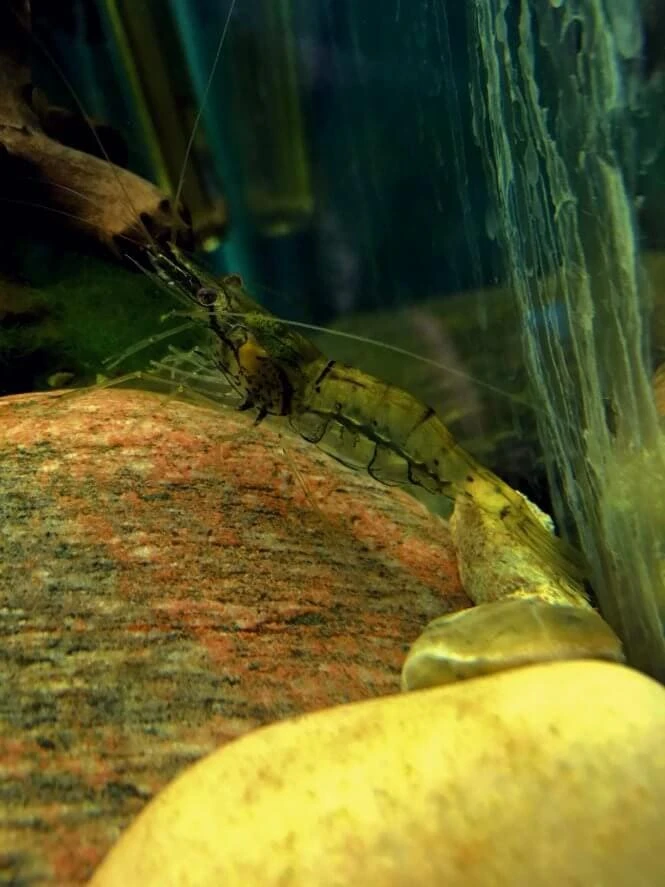
By 1mjustthecaretaker
| Maximum Size: | up to 1.5 inches (3.8 cm) |
| Suggested Tank Size: | 5 to 10 gallons as a minimum |
| Gets along with: | Small schooling Danios , Cherry barbs, schooling Tetras, small peaceful fish that would not eat the shrimp. |
The Ghost shrimp belong to the Macrobrachium genus and are small snail eaters.
By choosing the Ghost shrimp, you would make a great addition to a tank inhabited by a peaceful community of freshwater fish.
They are suitable for beginners because they are virtually maintenance-free.
Ghost shrimp don’t require any special care and get along with all small and peaceful fish.
While some of them will not bother the tiny snails and their eggs at all, others, such as the North American Glass or Ghost shrimp, will actively hunt them down.
Ghost shrimp are overall more aggressive and bulkier than most dwarf aquarium shrimp.
Reputable sellers will sell a type of Ghost shrimp that is not that aggressive – Palaemonetes Paludosus.
However, there’s a species of Ghost shrimp native to North America, named Palaemonetes kadiakensis.
These shrimp are full-blown carnivores and will readily snack on other aquarium snails.
In fact, fish stores do not always go the length of identifying the species of Ghost shrimp they are selling.
For example, the Macrobrachium Lanchesteri is another shrimp species that are almost identical to your “regular” Ghost shrimp and are very often sold under the same label.
Macrobrachium Ghost Shrimp can be really aggressive and will reduce an aquatic snail infestation to a minimum if let loose.

The only noticeable difference between a Macrobrachium Ghost shrimp and the common Palaemonetes Paludosus is the size of their front claws, with the Macrobrachium’s ones being visibly longer and larger.
The Macrobrachium Ghost shrimp use these relatively enlarged claws to pick up at the snails and sometimes outright gut them alive.
These shrimp may attack fish fry too.
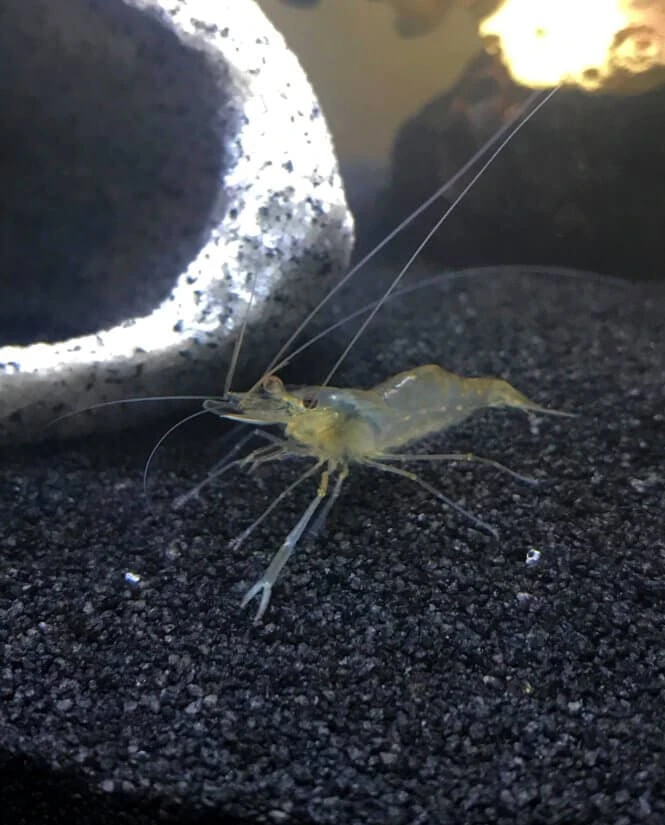
Here’s a photo of a juvenile Macrobrachium Lanchesteri:
By ImALiteralClam
13. Rainbow Darter Fish – Etheostoma caeruleum
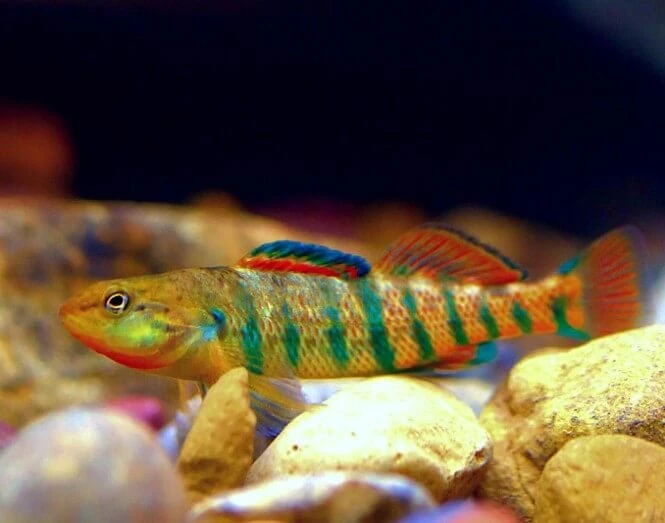
By vireovireo
| Maximum Size: | up to 3.5 inches (up to 9 cm) |
| Suggested Tank Size: | 20+ gallons |
| Gets along with: | similar-sized and peaceful fish like other Darters, Central Stonerollers, other minnows from their biotope, Shiner fish. |
Generally peaceful, the Rainbow Darter fish will chase and eat all the snails that may be populating your aquarium.
This species is part of the very numerous genus known as Etheostoma.
I know for a fact, from a friend of mine, his Rainbow Darters spend hours on the bottom, having fun with hunting snails.
Another great option from the native Darters is the Greenside Darter, as it also has an insatiable appetite for freshwater snails.
Anyway, being daytime predators, you may often see Rainbow Darter fish hunting for the snails at the bottom of the tank.
14. Oranda Goldfish – Carassius auratus

By CuntyCaldo
| Maximum Size: | 5 to 7 inches (12 to 18 cm), but some specimens may reach 15 inches (around 38 cm) when kept in ideal conditions |
| Suggested Tank Size: | 20 gallons or larger |
| Gets along with: | other Goldfish, Bristlenose Pleco, Zebra Danios, White Cloud Mountain Minnows. |
The Oranda Goldfish from the Carassius genus is not only one of the most popular goldfish species among hobbyists but also one of the best fish to join your fight against aquarium pest snails.
You could visit the link to learn more about this Goldfish type, but I’ll try to summarize what you need to know for now.
Anyway, the general life rule of the goldfish is: “if it fits in my mouth, I eat it”.
This rule includes other fish, snails, and shrimp that may live with a Goldfish. The menu of a Goldfish even includes vegetable matter and algae. You should not be surprised that I listed them as one of the best algae eaters for a pond, actually.
Anyhow, what I would like to mention here is that although a lot of people claim that goldfish would eat snails, but not shrimp, numerous people are reporting that the fish would also attack the smaller shrimp in the aquarium.
The only ornamental aquarium snail that may be able to live along an Oranda Goldfish is the Apple snail.
Its shell is hard enough to keep it safe from the Goldfish’s constant harassment.
Keep in mind that the ornamental snail may still get stressed and die from the ongoing pestering of the fish.
Smaller snails will be sucked up from their shells.
Anyway, do not forget that the Oranda Goldfish are not tropical fish and actually prefer colder water.
15. Dwarf Pufferfish – Carinotetraodon travancoricus

By heydoughnuts
| Maximum Size: | up to 1.5 inches or 3.8 cm |
| Suggested Tank Size: | for a lone specimen – 10 gallons, but a 5-gallon tank is possible if it’s heavily planted and also has floating aquarium plants. |
| Gets along with: | Danios, Tetras, Kuhli Loach, Cherry shrimp if the tank is big enough, Siamese Algae Eaters. |
Coming from the Carinotetraodon genus, the Pea or Dwarf Pufferfish is a tropical fish species, known for its small body size and relatively long lifespan of up to 4 years.
These qualities along with their peculiar character and visual appeal make the Dwarf Pufferfish a preferred fish choice for a small tropical aquarium.
On top of that, they are great snail-eating fish that remain small in their adulthood.
If your aquarium suffers from trumpet or bladder snail pests, the Dwarf Pufferfish will be of great help.
In fact, Dwarf Pufferfish owners often resort to feeder snails as a treat for their pufferfish.
However, if you explore the option of getting this fish, remember – they are aggressive by nature.
Very similar to the Betta fish, the Pea pufferfish are territorial and depending on their individuality, they might get along with the rest of the tank inhabitants, or they might constantly harass them.
Make sure, your fish tank provides enough swimming space and hiding spots for this small pufferfish species and you might be lucky enough to have a peaceful aquarium.
Recommended equipment for a Dwarf Pufferfish: Small Heaters for 5 and 10-gallon Aquariums
16. Bala Shark – Balantiocheilos melanopterus
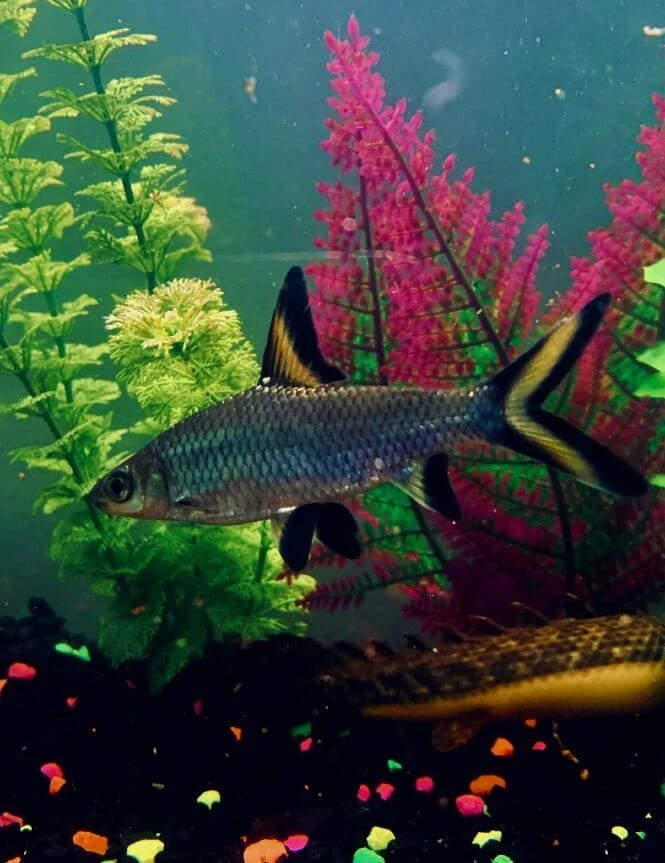
By Dmist10
| Maximum Size: | up to 15 inches (up to around 38 cm) |
| Suggested Tank Size: | 75 gallons for one mature Bala Shark and 200 or even 400 if you keep 3 or 4 of them. |
| Gets along with: | larger fish with a peaceful temperament who do not fit the mouth of a Bala Shark. Gourami fish, Loaches, angelfish and other cichlids, schools of tiger or tinfoil barbs, Oscars, some rainbowfish. |
The Bala Shark is a large species of fish, a member of a small genus known as Balantiocheilos, that can keep a freshwater aquarium infested with snails under control.
Bala sharks are one of the many freshwater members of the Cyprinidae family that resemble actual sharks in behavior and looks and can be kept in an aquarium.
Opposite to their name, they are very peaceful fish.
You can keep them with a large variety of tank mates, except for snails and shrimp species, as those are usually their preferred snacks.
A big disadvantage, however, is their mature size.
When they are young and small, the smaller aquariums will do the job, but once The Bala sharks are fully grown, they will need a lot of space because of their active nature.
It’s also worth noting that some small schooling species such as the neon tetra, might become potential prey.
17. Dwarf Gourami – Trichogaster lalius

By tristanbillings
| Maximum Size: | 3 to 3.5 inches (7.6 cm to 8.9 cm) |
| Suggested Tank Size: | 10 gallons and more. |
| Gets along with: | Plecos, Mollies, Danios, Cory catfish, Neon Tetra, Rasbora fish. |
My experience has been that the Dwarf Gourami is, perhaps, the best choice for a snail-eating fish in a 10-gallon tank.
This fish comes from the Trichogaster genus, native to South Asia from Pakistan to Myanmar.
The Dwarf Gouramis are not too big when grown-up as they reach a maximum adult size of 2.5 to 3 inches.
Also, they get along with almost all non-aggressive species that are close to their size.
This, in my opinion, makes the Dwarf Gourami a really cool freshwater aquarium fish overall.
Dwarf Gouramis are not schooling fish, so you can decide whether to keep them alone, or have a couple of them in the fish tank.
Note that keeping a few male dwarf Gouramis together may unlock their territorial behavior.
Also, it’s not a good idea to keep them with other larger Gourami fish as the bigger specimens may attack the dwarfs.
Dwarf Gouramis prefer heavily planted fish tanks.
Some favorite snacks of the Dwarf Gouramis are the Pond snail babies and other small snails that can fit into their mouths.
18. Golden Topminnow – Fundulus chrysotus
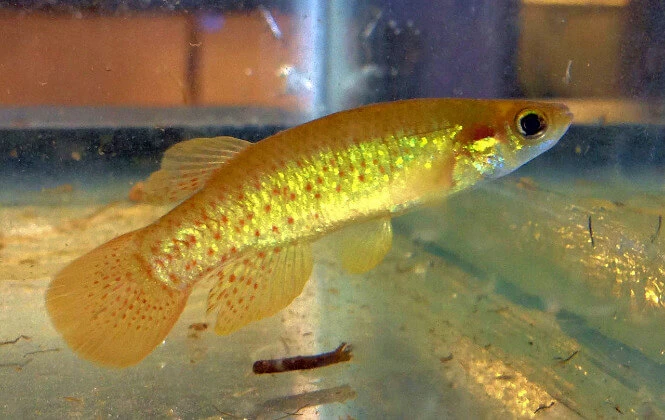
By Fredlyfish4
| Maximum Size: | up to 2.5 inches (around 6.5 cm) |
| Suggested Tank Size: | 20 gallons (long tank) for a school of 4, but preferably 30. |
| Gets along with: | Darter fish, American Flagfish, Rainwater Killifish. |
Easy to be found in ditches and swamps, Golden Topminnows will do a great job at feeding on pest snails in your aquarium.
These North American fish also like mosquito larvae and water beetles.
The Golden Topminnow is one of the over 35 recognized species in the Fundulus genus.
Usually, they will spend most of the time at the surface of a fish tank.
To avoid aggression, keep them in a school of 4 to 6.
You will likely witness them chasing each other and playing most of the time, not paying attention to the rest of the fish in the tank.
19. Zebra Loach – Botia striata
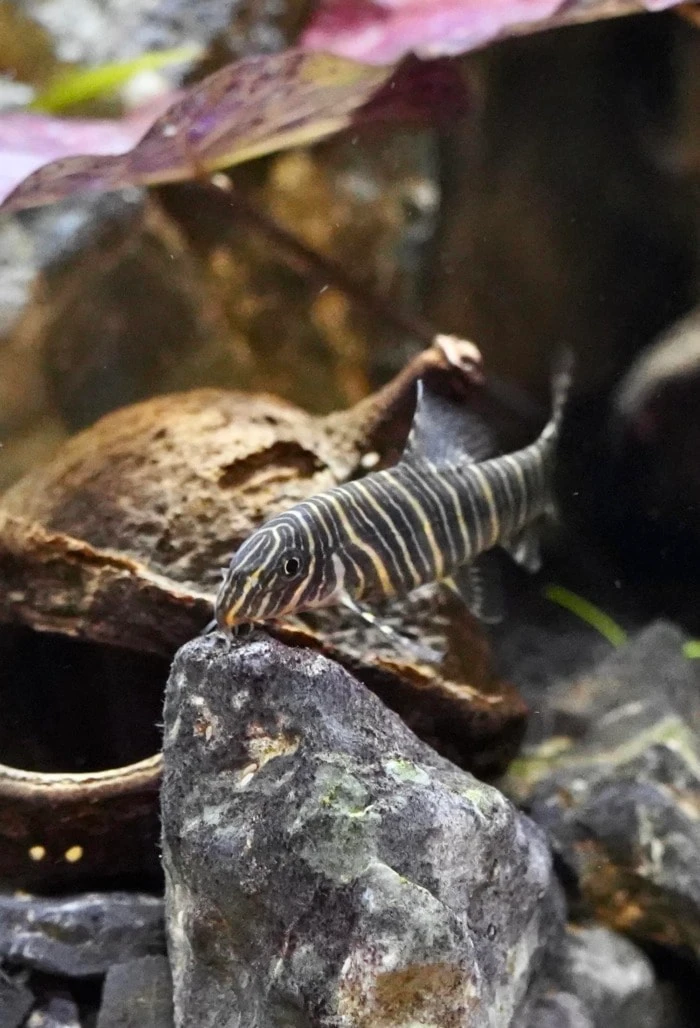
By BrianSchultz
| Maximum Size: | 3.5 inches (9 cm) |
| Suggested Tank Size: | 30 gallons |
| Gets along with: | Most tetras and other small schooling fish, other types of loaches not big enough to bully the Zebra |
Zebra Loaches are another fish from the Botia genus, which inhabit the bottom of rivers and streams in India.
Being a bottom-dwelling fish with a taste for meat, they evolved to hunt down and eat all kinds of aquatic snails.
Zebra loaches can be very quick to eliminate entire populations of aquarium snails.
Though these loaches grow to just about 3.5 inches (9 cm) they will need a rather spacious tank to feel comfortable.
That’s because Zebra loaches are a social fish and need to be among others of their kin.
Keeping a group of 5 to 6 Zebra loaches is recommended so that they can establish their internal social hierarchy.
I’d say that a 30-gallon tank will do as the minimum for Zebra Loaches.
Natural snail control and new fish compatibility
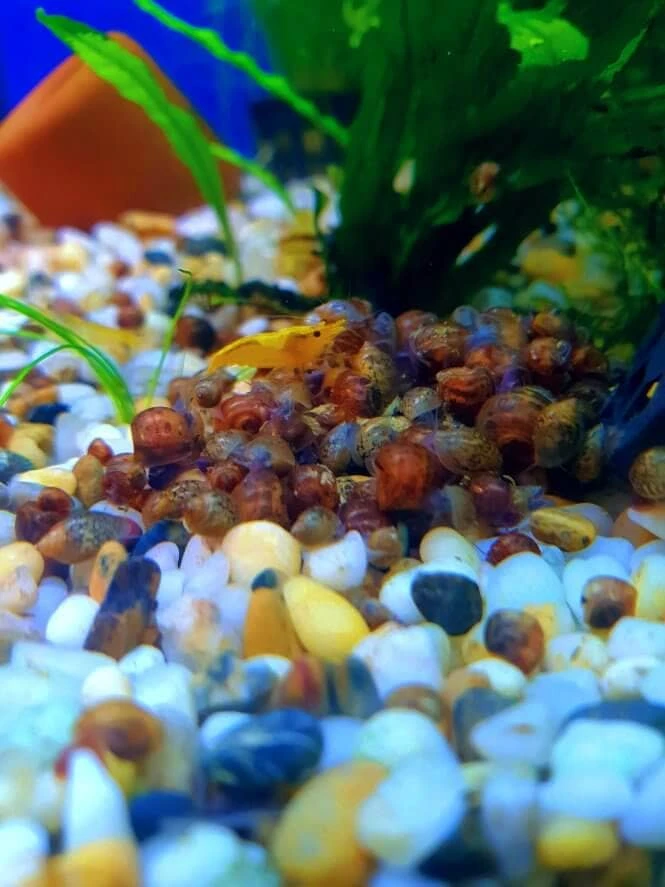
By angusplazgames
Whenever you consider adding a snail-eating fish or invertebrate to your fish tank, don’t forget to do a proper research beforehand.
The aquarium pest snail eater you choose should feel comfortable among the rest of the residents there and should be suitable for the maintained water conditions.
Otherwise, you risk turning your aquarium into a dangerous place for some of the fish by mixing incompatible species.
Employing snail predators in the fight with an ongoing snail pest infestation is only wise when your aquarium setup allows it.
Apart from that, there are some other practices for natural snail control in a fish tank:
- Control the algae growth.
Having small amounts of algae growing here and there in the fish tank is something you can get away with.When too much, however, the algae will serve as a food source for the snails, hence, they will grow and reproduce faster.
Algae could also affect the quality of the aquarium’s water.
You should perform a regular water change, avoid overfeeding the tank inhabitants, and if needed, you can scrape the algae yourself.
- Don’t overfeed your fish.
Overfeeding our fish tank pets is a quite common mistake that even advanced hobbyists could make.No need to feed your fish a few times per day, one or two times can be enough.
The more food you give the fish, the more leftovers for the snails.
The unconsumed food may also rot at the bottom of the tank or in the filter, which can, again, result in bad water conditions.
Cloudy aquarium water, for example, is a sure sign that there is too much organic waste in the fish tank.
- Clean the bottom of your tank.
You can use a gravel vacuum of some sort, which will help you reduce the number of snail eggs, parasites eggs, and any food leftovers (click the link to Amazon.com to see one that’s really popular).There are lots of options on the market at the moment, and they come with clear and easy instructions.
When it comes to fully grown adult snails, you can try removing them by hand.
Sure, you will spend some time, but the results may be worth it.
- Use traps made for snails.
What I found to be the easiest way to catch a good number of snails is using a lettuce leaf.Take a big piece of lettuce and attach it to one of the walls by clipping it.
Leave it for one night, and you will be surprised by the large number of snails you will find on it in the morning.
Remove the leaf, along with the snails. If you don’t like this technique, you can alternatively use a snail trap.
Those can be found in any pet store or on the web. Same as above, there are different types and they are pretty easy to use.
What’s the best aquarium snail eater for a beginner?
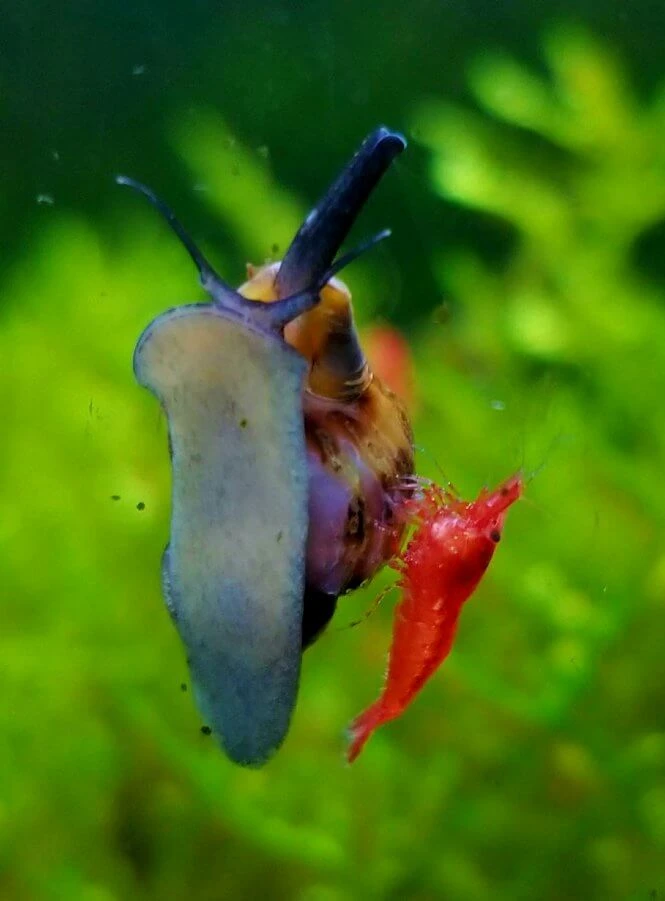
By Electrician4Hire
Despite all the options we have when choosing a fish for a community tank, we need to be honest that not all of the species are suitable for beginners.
With that in mind, finding the best aquarium snail eater for a beginner might be a difficult task as well.
Although I found out about the Assassin snail quite late in my aquarium journey, I think it’s the best snail-eater ever.
Known for its peaceful temperament, that snail gets along with any fish, except the bigger and more aggressive ones.
The Assassin Snail is also a suitable choice for small 10-gallon fish tanks, which is what most beginners start with.
The Dwarf Gourami is another good choice that suits beginners who are looking for pet fish that eat pest snails.
They are also suitable for 10-gallon aquariums, as Dwarf Gouramis are not schooling fish and can therefore be an effective snail eater in a smaller tank.
Dwarf Gouramis can be kept with a variety of other fish, and don’t grow much in size, making them a really good fit for a beginner.
Getting lucky with the right kind of Ghost shrimp is also one of the better options for snail control.
Drop me a comment below if you need more Aquanswers.


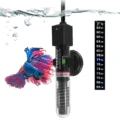
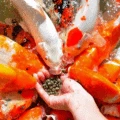
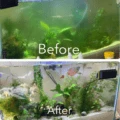

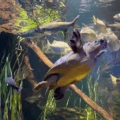
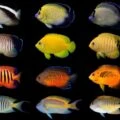



I’ve got a 13 gallon tank with 4 mollies, 5 cherry shrimp, 3 tetra GloFish, 1 Nerite snail, and 3 mystery snails. I have a handful of live plants in there and had some unwelcome hitch hikers when I added the newest ones. My tank now has pond snails in it. I’ve done water changes, cut down on feeding, but I’ve already got a problem.
Is there anything I can add that gets along with my fish/snail/shrimp community but will gladly snack on the pond snails? Or am I better off hand picking the adults out of the tank?
I have a warm 30 litre tank that has 2 Galaxy Rasbora fish, 4 Red Cherry Shrimp, way too many snails, and is absolutely packed with live plants. What would you recommend that would eat newborn shrimp and baby snails (0.5cm) but leave the adult shrimp (2cm) and adult snails (2cm) alone?
Hi Sophia,
Difficult question.
From my experience, the Galaxy Rasbora would eat baby shrimp at any given opportunity. Now, the question is could you put more GRs in your 5-gallon tank.
I personally would not recommend these nano fish for this volume of water because they are somewhat active swimmers and need to stay in groups.
However, seeing that your tank has lots of plants you could likely put a few more in there, which shouldn’t result in aggression, fin nipping, etc.
So 30 litres is around 7.5 gallons, which means that you could bump their total number to, say, 5. In my articles, I usually recommend a 10-gallon tank for 6-7 specimens, but a heavily planted tank always makes overstocking more doable, because the plants will break line of sight and keep the aquarium’s water clean.
To stimulate their appetite for baby shrimp you can, in fact, feed them some other “natural” foods, such as Daphnia (my top recommendation) or brine shrimp. This way they’ll get more used to their natural taste and it will bring out their hunting instinct. The GBs are too small to cause problems for adult shrimp but will definitely eat shrimp fry.
Now, about the snails… For this tank size, I can only recommend a Spixi snail or two. The Spixi snails will eat most snails they come across and do not need a large tank as an Assasin snail would. There no animal that would fit in this tank size that would eat small snails but will leave alone the larger ones, in my experience. So with the Spixi snail, there may be some mature snail casualties, just so you know.
Of course, monitor your bioload when adding the GBs and the snails. You could even pour in some bottled bacteria to make sure the Nitrogen Cycle in the aquarium remains stable.
I hope this is of help. Let me know if you have other questions.